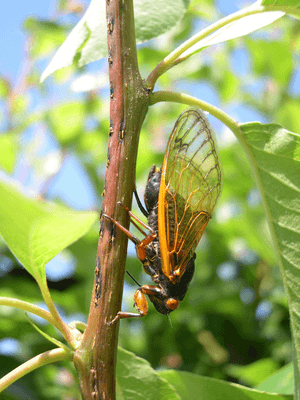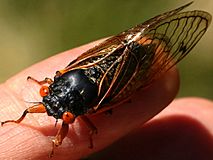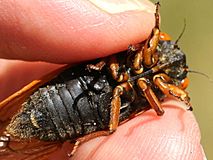Magicicada cassinii facts for kids
Quick facts for kids Magicicada cassinii |
|
|---|---|
 |
|
| Female ovipositing | |
| Conservation status | |
| Scientific classification | |
| Genus: |
Magicicada
|
| Species: |
cassinii
|
| Synonyms | |
|
Cicada cassinii Fisher, 1852 |
|
The Magicicada cassinii is a special type of insect called a periodical cicada. People also call it the 17-year cicada or Cassin's periodical cicada. This cicada lives only in North America. It spends 17 years growing underground before it comes out. It looks very much like another cicada, Magicicada tredecassini, which has a 13-year life cycle.
Scientists often talk about these two types together as "cassini-type periodical cicadas." What makes the cassini-type special is how the males sing. Thousands of male cicadas can sing and fly together at the same time. The name cassinii was given to honor John Cassin, an American bird expert.
Contents
What Does the 17-Year Cicada Look Like?
Adult M. cassinii cicadas look a lot like other periodical cicadas. They are about 24 to 27 millimeters (about 1 inch) long. This measurement is from the front of their head to the tip of their wings.
Their head is black, and their eyes are big and red. The top part of their body, called the pronotum, is black. It has a thin orange band around the edge. Their main body, the abdomen, is also black. Their legs are orange. Their wings are clear, with orange lines and dark spots near the ends.
Where Do Cassin's Periodical Cicadas Live?
Magicicada cassinii lives only in North America. You can find them across the northern parts of the United States and in southern Canada.
The Amazing Life Cycle of the 17-Year Cicada
These cicadas are a type of true bug. After they come out from underground, the adult cicadas drink sap from trees and bushes. Male cicadas gather in large groups and sing loudly to attract females. Their song lasts for about two to four seconds. It sounds like a series of clicks, followed by a long buzzing sound that gets louder and then softer. After singing, the males fly to a new spot and start their song again.
After mating, the female cicadas use a special tool called an ovipositor to lay their eggs inside tree branches. The eggs hatch about two months later. Tiny baby cicadas, called nymphs, then drop to the ground. They dig underground and start drinking sap from small tree roots. This sap does not have much food in it, so the nymphs grow very slowly.
They will shed their skin five times as they grow. They move to bigger roots deeper in the soil over 17 years. Finally, they dig tunnels up to the surface and come out into the open air. They climb up plants and shed their skin one last time to become adult cicadas.
Even though each group of cicadas has a 17-year life cycle, sometimes things in nature can change this pattern. There are different groups, called "broods," that come out in different years. Their life cycle can actually be anywhere from 13 to 21 years long.
These different broods have numbers. For example, Brood X was expected to come out in many states like Delaware, Georgia, and New York in May and June 2021. Some broods also have smaller groups that come out a few years early. For instance, a part of Brood XIII in the Chicago area came out four years early in 2020.
-
Male dorsal Brood XIII sub-brood, Naperville, Illinois June 13, 2020
-
Male ventral Brood XIII sub-brood, Naperville, Illinois June 13, 2020
How Cicadas Affect Trees
When many cicadas emerge, they can cause some harm to trees. This is especially true for young trees. Female cicadas make a small cut in a twig to lay their eggs. This can make the branch droop or lose its leaves. In larger branches, these cuts might allow germs to enter.
The large number of nymphs feeding underground also uses a lot of sap. However, studies show that mature trees usually do not suffer long-term harm from cicadas.
The Myth of Blue-Eyed Cicada Rewards
There's a common urban legend that says you can get a lot of money for finding a rare blue-eyed cicada. The story claims that science labs, like one at Vanderbilt University, will pay up to a million dollars for one.
It's true that blue-eyed cicadas are very rare. Only about one in a million cicadas has blue eyes. But no laboratories currently offer any such reward.
However, a cicada expert named Roy Troutman did offer rewards for living blue-eyed cicadas in 2008. He did this for his cicada research. But he is no longer offering these rewards.




